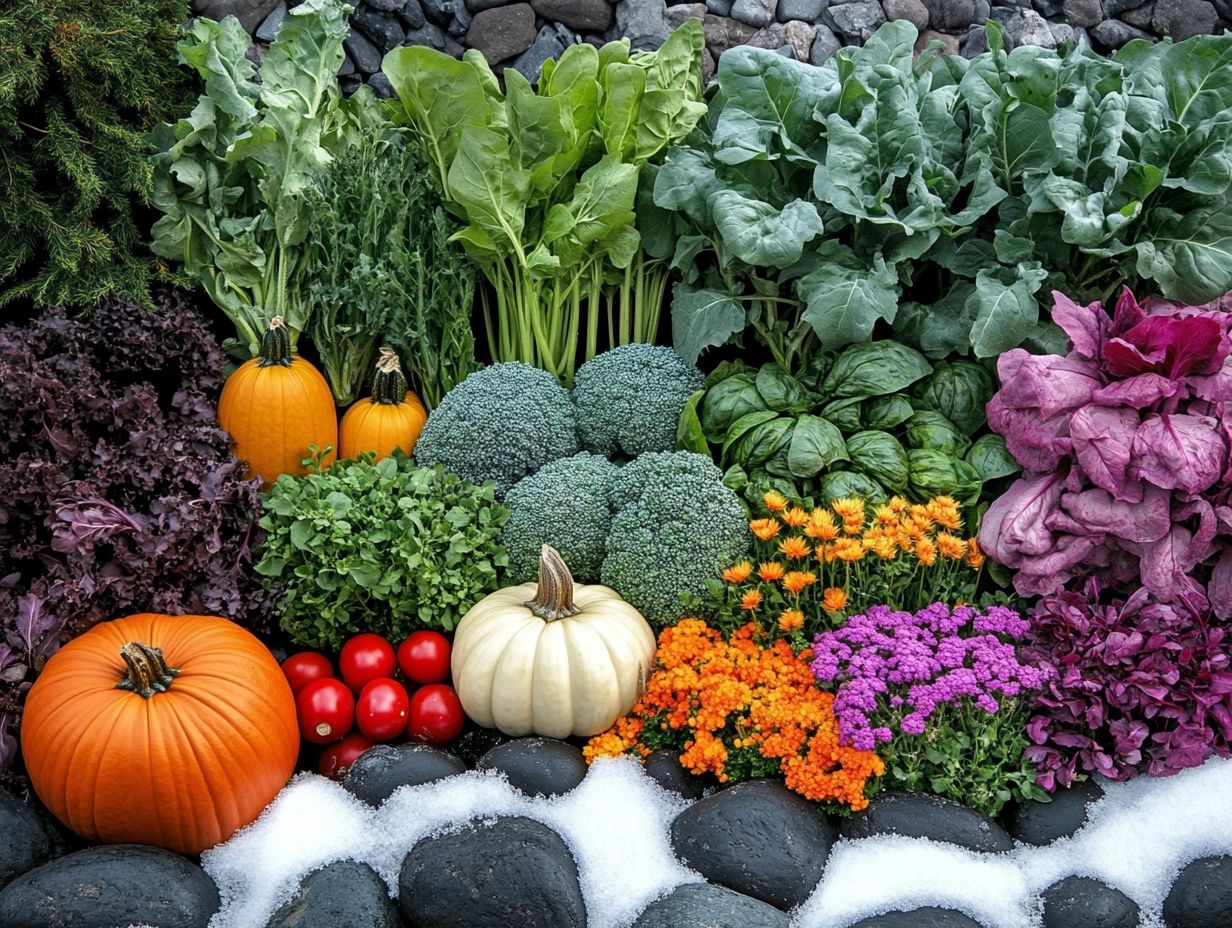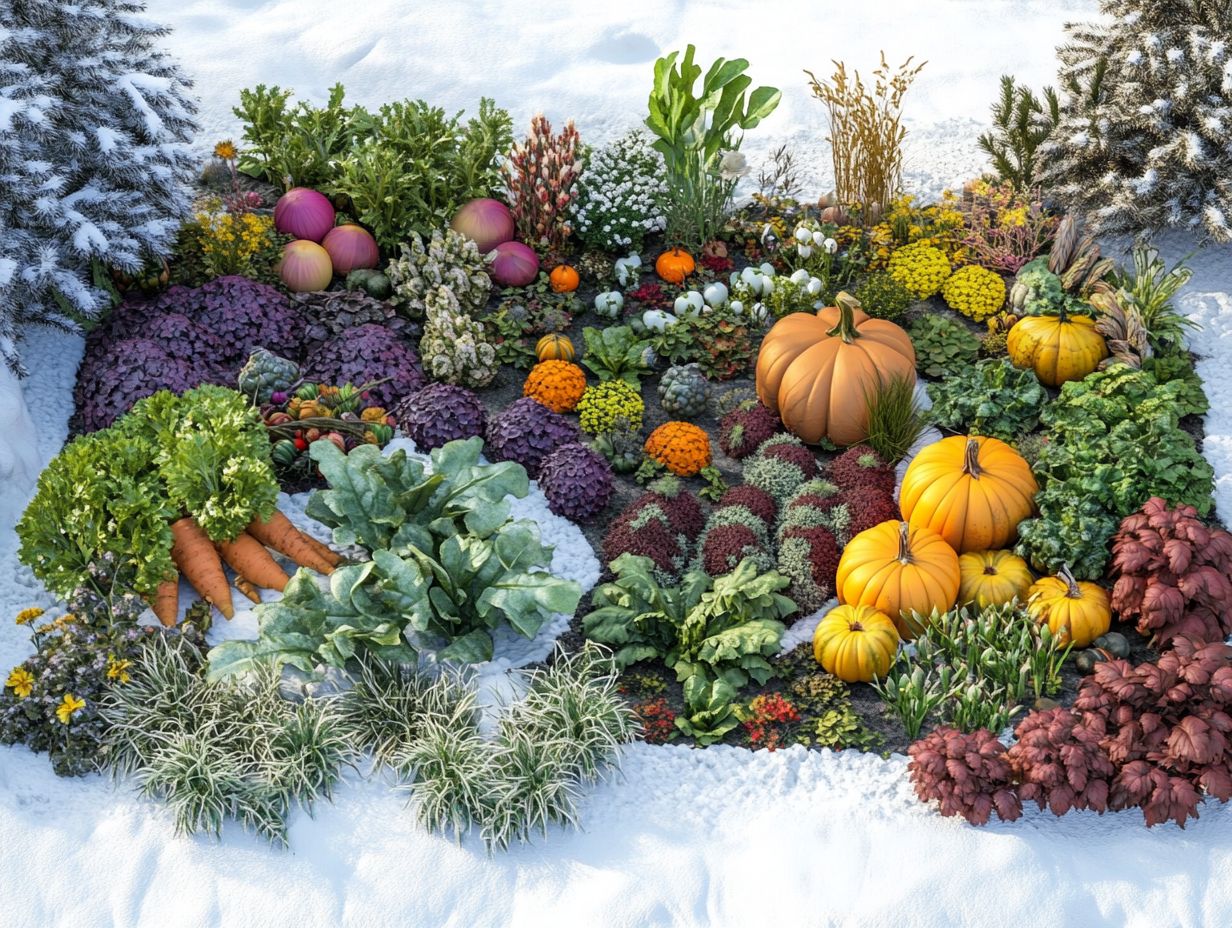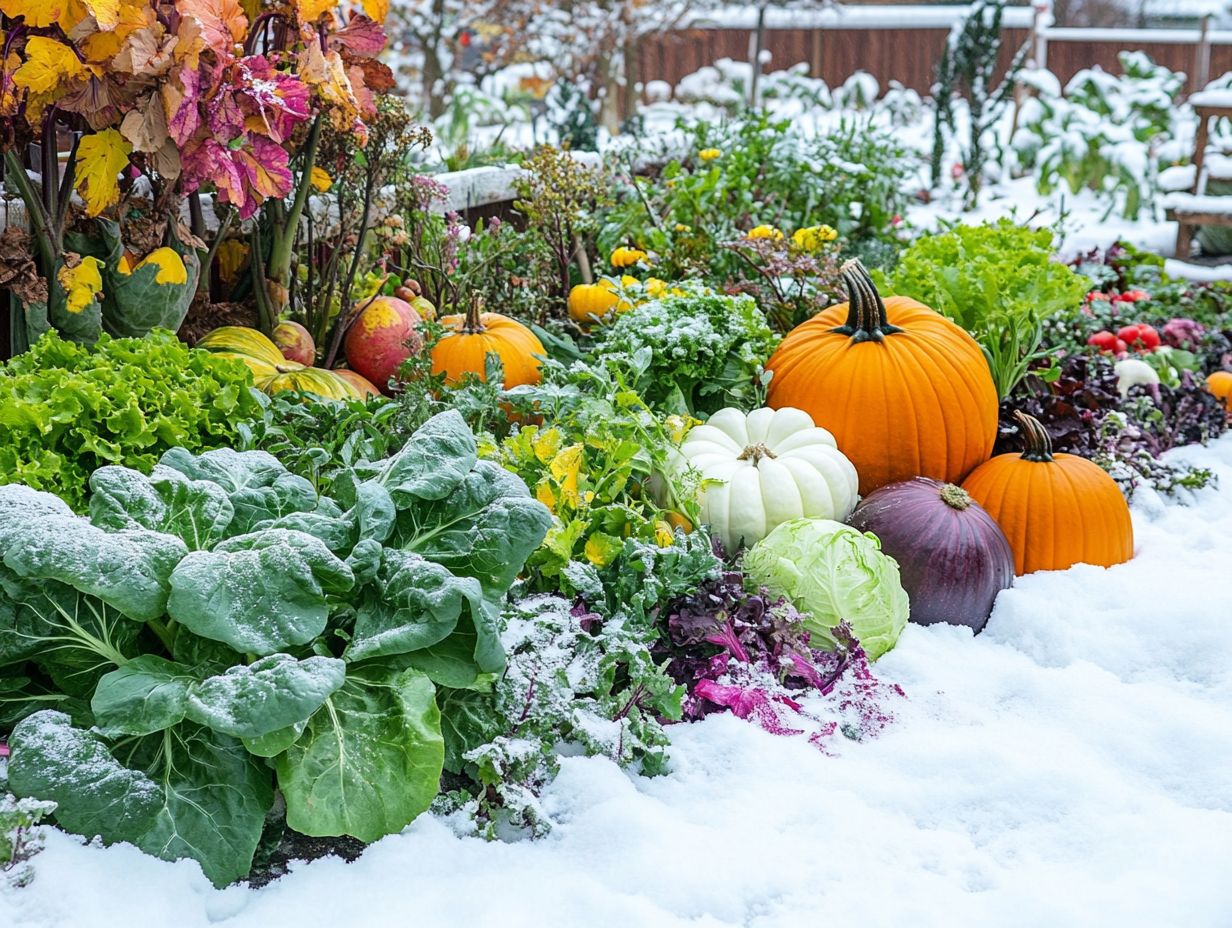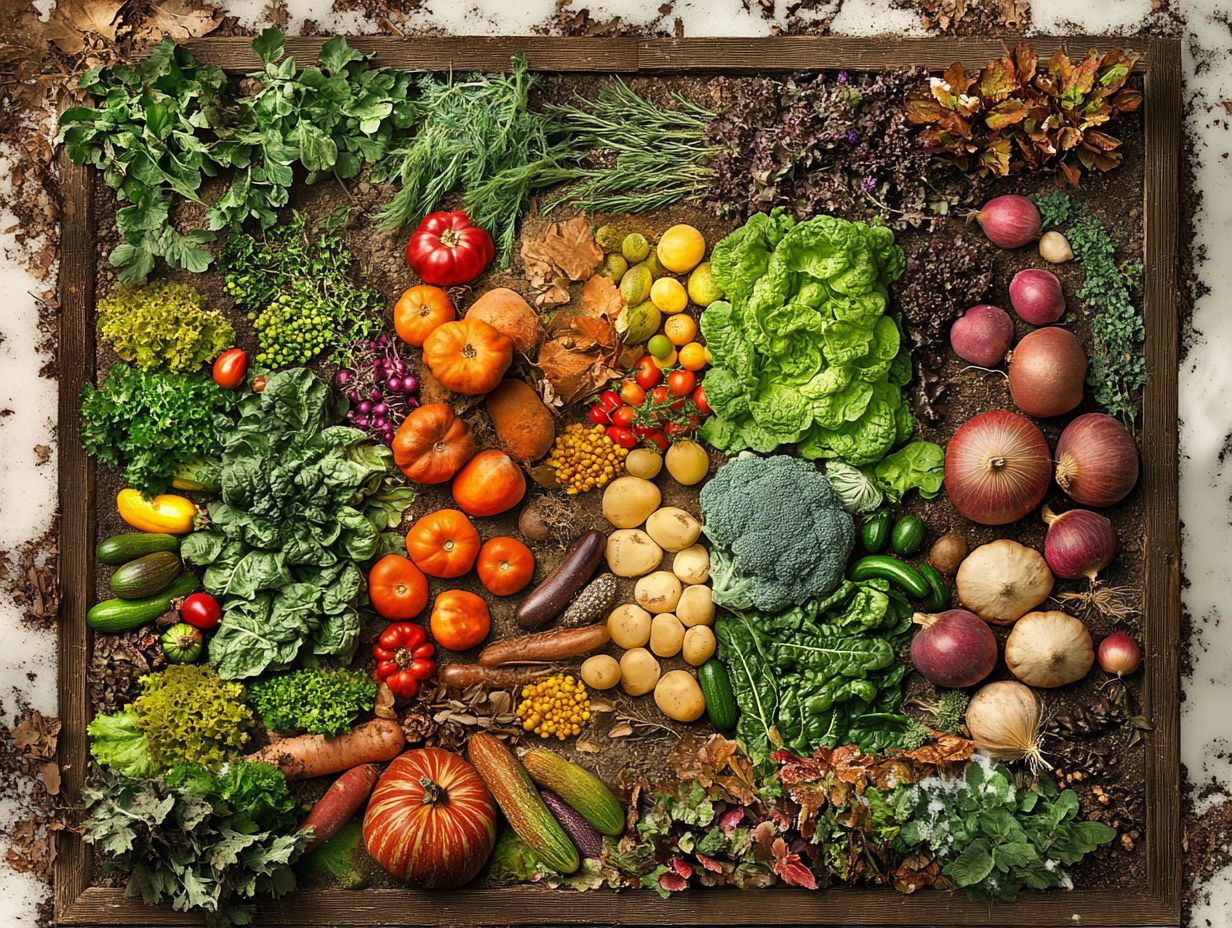Understanding Seasonal Changes in Edible Plants
Seasonal changes are pivotal in the realm of edible plants, impacting everything from their nutritional value and flavor to their availability and cost. By recognizing these shifts, you can elevate your diet and enrich your cooking experiences.
Get ready to discover how to identify the signs of seasonal changes, adjust your meal planning to align with them, and appreciate the myriad benefits of eating in tune with the seasons.
Discover the dynamic relationship between nature and your plate, and unlock the full potential of seasonal eating.
Contents
- Key Takeaways:
- What are Seasonal Changes?
- Why Understanding Seasonal Changes is Important for Edible Plants
- Identifying Seasonal Changes in Edible Plants
- Adapting to Seasonal Changes in Edible Plants
- Benefits of Eating Seasonally
- Frequently Asked Questions
- What are seasonal changes in edible plants?
- Why is it important to understand seasonal changes in edible plants?
- How do seasonal changes affect the taste and nutritional value of edible plants?
- What are some examples of edible plants that have seasonal changes?
- Can seasonal changes affect the availability of edible plants?
- How can I continue to enjoy edible plants even when they are out of season?
Key Takeaways:

What are Seasonal Changes?
Seasonal changes encompass the natural fluctuations in weather and climate throughout the year. These changes influence everything from temperature to daylight hours. Understanding these shifts is essential for multiple facets of agriculture, particularly regarding seasonal eating and food seasonality.
For example, fruits and vegetables thrive during specific times of the year, dictated by natural periods when plants grow best. These shifts not only affect local farmers but also bolster community-supported agriculture, fostering a more resilient and vibrant local economy.
Why Understanding Seasonal Changes is Important for Edible Plants
Understanding seasonal changes is essential for maximizing the nutritional value and health benefits of edible plants, as these factors are closely tied to their growth cycles and harvest times. Embracing seasonal eating encourages you to select local produce available at farmers markets, allowing your community to thrive on fresh and nutrient-rich foods.
By aligning your diet with the natural growing rhythms of fruits, vegetables, and various produce, you not only elevate your health but also champion sustainable practices and reduce your carbon footprint.
Impact on Nutritional Value and Taste
The impact of seasonal changes on the nutritional value and taste of edible plants is remarkable. When you harvest produce at its peak, you’ll find it brims with higher nutrient content and superior flavor profiles.
Understanding food seasonality helps you incorporate seasonal foods into your diet, enhancing your health benefits while playing a role in reducing the carbon footprint linked to long-distance transportation and storage.
Take, for example, the explosion of flavor found in summer tomatoes. Ripe and juicy, they soak up the warm sun, packed with vitamins C and K that elevate any dish. Then, as fall approaches, root vegetables like sweet potatoes and beets take the spotlight, offering a delightful sweetness along with a wealth of essential minerals and antioxidants.
These seasonal foods not only taste better, but they also deliver optimal health benefits, such as improved immune function and better digestion. By embracing these natural cycles, you can enjoy the freshest and most nutritious options available, ultimately leading to enhanced overall well-being.
Availability and Cost

The availability and cost of seasonal produce fluctuate significantly throughout the year, shaped by the natural times when plants grow and local selections in grocery stores and farmers’ markets. By understanding these patterns, you can make informed choices, ensuring you enjoy fresh, affordable fruits and vegetables that align beautifully with nature’s rhythm.
When you opt for seasonal items, you ll likely notice lower prices compared to out-of-season produce, which often incurs higher transportation costs and extended storage times. This cost-effectiveness not only benefits your wallet but also elevates the quality and flavor of the food you consume.
Choosing locally sourced produce strengthens your community’s economy. Your spending at nearby farms tends to circulate within the local area, supporting the livelihoods of growers. This also contributes to a more sustainable agricultural system. By embracing seasonal shopping habits, you can truly savor the essence of fresh food while participating in a cycle that nurtures your community.
Identifying Seasonal Changes in Edible Plants
Identifying seasonal changes in edible plants requires your keen observation of the signs and indicators that mark the shift in growing cycles. This knowledge gives the power to both gardeners and consumers to know precisely when to plant, harvest, and indulge in seasonal produce.
You ll notice changes in temperature, variations in daylight, and the behavior of local flora. All of these intricately influence the optimal times for planting and harvesting a diverse array of food varieties.
Signs and Indicators
Several signs and indicators can help you identify seasonal changes, such as the blooming of edible flowers, shifts in wildlife behavior, and the emergence of specific crop varieties that flourish in certain months. Observing these natural cues is essential for anyone engaged in seasonal eating or gardening practices.
For instance, the cheerful song of returning migratory birds, like robins or swallows, can signal the delightful transition from winter to spring. The blossoming of magnolias or cherry trees not only enhances the landscape’s beauty but also hints that summer produce, like tomatoes and peppers, will soon be ripe for the picking.
When you notice an abundance of asparagus or strawberries in local markets, seize the chance to make these fresh, seasonal ingredients the star of your meals. By being more attuned to these environmental changes, you can truly appreciate the rhythm of nature and elevate your culinary experiences while supporting local agriculture.
Adapting to Seasonal Changes in Edible Plants
Adapting to the seasonal changes in edible plants calls for a proactive approach to meal planning and a genuine willingness to cultivate your own food. This gives you the power to fully embrace the freshness and health benefits that each season offers.
By centering your meals around seasonal produce, you can ensure a diverse, nutrient-rich diet that harmonizes with the natural growing cycles of fruits and vegetables.
Adjusting Diet and Meal Planning

Adjusting your diet and meal planning to embrace seasonal foods not only bolsters healthy eating but also sparks culinary creativity. This allows you to savor a wider array of flavors and nutrients.
By concentrating on what s fresh and in season, you can create meals that are not just delicious but also harmonize beautifully with the natural rhythms of the food cycle.
Exploring local farmers’ markets presents a wonderful opportunity to uncover the produce currently available. These markets typically showcase the finest offerings from local farmers.
Engaging with vendors ensures you re sourcing quality ingredients. It also cultivates a sense of community.
Seasonal recipes can simplify your meal planning, focusing on ingredients at their peak. This guarantees vibrant flavors and enhanced nutrient retention.
By adopting this approach, you can elevate your well-being while also contributing to the local economy, supporting sustainable farming practices, and strengthening connections between consumers and growers.
Preserving and Storing Seasonal Produce
Preserving and storing seasonal produce is not just a skill; it’s an art that allows you to savor fresh foods all year round. By mastering this craft, you can relish the health benefits of seasonal fruits and vegetables long after their peak season has passed.
Techniques like canning, freezing, and fermenting not only minimize nutrient loss but also create opportunities for community engagement through shared experiences and methods.
When you learn effective preservation techniques, you ensure that your harvest is enjoyed fresh and transformed into mouthwatering meals even in the heart of winter. Thanks to a wealth of step-by-step guides available online, you can easily dive into everything from beginner canning tutorials to advanced fermentation workshops.
Join local community groups and supercharge your learning experience! Exchanging techniques and stories fosters a supportive network dedicated to sustainable practices. Food education is key in this process, giving you the power to maximize your seasonal produce while taking care of our environment.
Benefits of Eating Seasonally
Embracing seasonal eating offers a wealth of benefits that enhance not only your personal health but also the environment. By indulging in fresh, locally sourced foods, you reap nutritional rewards while fostering the variety of life found in a specific area within local ecosystems.
This sustainable approach elevates the quality of your diet. It also supports local farmers, bolstering the community economy and creating a more vibrant, interconnected system.
Nutritional and Environmental Benefits
The nutritional and environmental benefits of seasonal eating are impressive. You gain a treasure trove of vitamins and minerals from freshly harvested produce while actively reducing the carbon footprint linked to long-distance food transportation.
By choosing to support local farmers and incorporating seasonal foods into your diet, you ensure that you re maximizing nutritional value while contributing to a healthier planet. When you opt for in-season fruits and vegetables, you re indulging in superior taste and freshness.
You’re also gaining essential nutrients that often diminish in out-of-season options due to prolonged storage. For example, savoring strawberries at their peak can provide you with higher levels of vitamin C compared to those shipped from afar.
Embracing seasonal eating not only fosters healthier habits but also encourages you to explore a delightful variety of ingredients. These practices align beautifully with sustainable food systems, stimulating local economies and minimizing waste associated with transporting perishable goods.
Ultimately, seasonal eating offers a dual advantage nourishing your body while nurturing the ecosystem.
Frequently Asked Questions

What are seasonal changes in edible plants?
Seasonal changes in edible plants refer to the natural changes that occur in the growth, development, and availability of plants that are suitable for consumption during different times of the year.
Why is it important to understand seasonal changes in edible plants?
Understanding seasonal changes in edible plants can help individuals make informed decisions about what to grow, when to grow it, and when to harvest for optimal taste and nutritional value. For a deeper insight, understanding the life cycle of edible plants can also assist in planning meals based on what is in season and easily accessible.
How do seasonal changes affect the taste and nutritional value of edible plants?
Seasonal changes, such as temperature, sunlight, and rainfall, can impact the taste and nutritional value of plants. For example, plants grown in colder temperatures may have a sweeter taste, while those grown in warmer temperatures may be more bitter.
Furthermore, different seasons may provide different nutrients for plants to absorb, affecting their nutritional value.
What are some examples of edible plants that have seasonal changes?
Some examples of edible plants that have seasonal changes include fruits, vegetables, and herbs. For instance, strawberries are typically harvested in the summer, while Brussels sprouts are harvested in the fall.
Herbs like cilantro thrive in the cooler temperatures of spring and fall but may wilt or bolt in the summer heat.
Can seasonal changes affect the availability of edible plants?
Yes, seasonal changes can change the availability of edible plants. Some plants are only available during certain times of the year.
Others might be available year-round but vary in price and quality. Knowing these changes helps you select and buy the best plants.
How can I continue to enjoy edible plants even when they are out of season?
There are several ways to enjoy edible plants even when they are out of season. You can freeze, can, or preserve them to enjoy later.
Another option is to buy them from a local farmer’s market or grocery store that imports from other regions. Frozen or canned versions are also great choices and are usually available all year!






